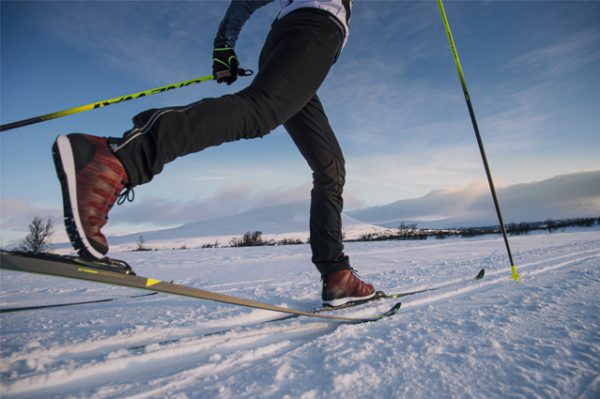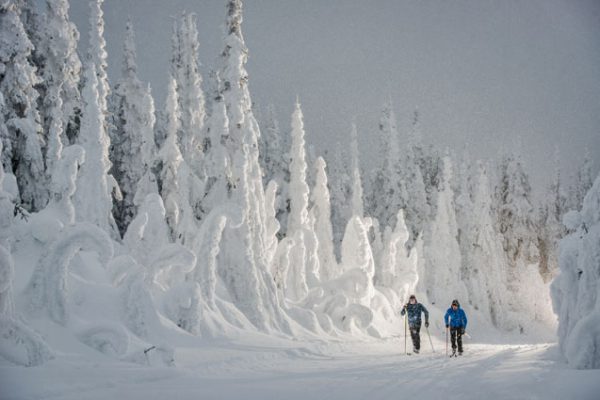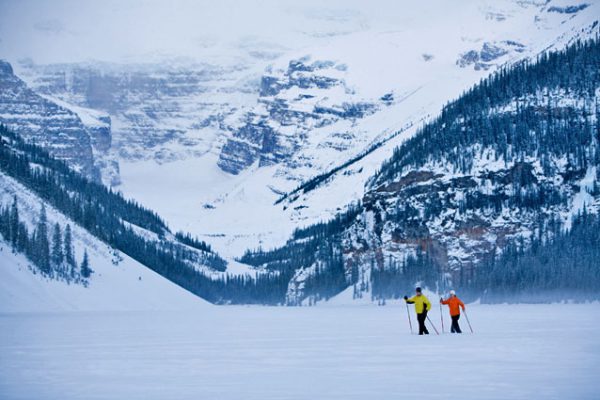Will this be the winter you add cross-country skiing to your outdoor plans?

You may notice an ever more common exotic species darting around the base areas of ski resorts this season. I’m talking about those slender figures that lope lithely in skinny leggings stretching to contain muscular thighs. But this might just be the year to consider joining their ranks. A tranquil yet invigorating, socially distanced glide through the forest on cross-country ski gear could become a pillar of your pandemic survival strategy.
Alpine skiers already participate with masks, gloves and goggles, so no one is claiming that our sport is a dangerous activity in the Covid era, but count us in the camp that believes any time spent skiing would be a net benefit to our health. Given how much of normal life has been disrupted, maybe it’s time to get out of old ruts and into a new, track-set groove. Let 2021 be the year you stride into, or return to, cross-country, if for no other reason than to extend your ski holiday and not return to your Zoom calls and the Netflix couch.
Here’s a quick look at some favourite alpine resorts that also have some not-so-gnarly Nordic networks at or near the base area. Expand your ski repertoire this season: grab a trail map and plan your departure days accordingly.
How to buy cross-country ski gear
WHISTLER BLACKCOMB
Not surprisingly, Whistler Blackcomb has lots to offer those on skinny skis. Indeed, Canada’s mega-resort has more than 160 km of cross-country trails in the area. Minutes from Whistler Village, Lost Lake Park accounts for 30 of those kilometres, with lessons and rentals available at the Lost Lake PassivHaus. Whistler Olympic Park is home to 90 km for classic or skate skiing, with 30 of those kilometres welcoming K-9 companions. Some of Callaghan Country’s 87 km of trails lead to Journeyman Lodge for an overnight option at a backcountry hut high in the alpine.
SUN PEAKS
Sun Peaks is where the skiing worlds collide. Slide through the lift corral on your skinny skis and straight onto a chairlift for a helping hand up to the Holy Cow trail, where the higher elevations preserve the snow quality as well as provide the views that give the trail its well-deserved name. Holy Cow connects to the rest of Sun Peaks’s 37-km network. For a destination worth working toward, head out to the McGillivray Lake Outpost, a welcome warming hut overlooking the picturesque namesake lake.
SILVERSTAR
At SilverStar, cross-country skiers can go big at the resort’s 55 km of trails—and then go even bigger along an additional 50 km of trails at the connected Sovereign Lake Nordic Centre. Combined, they offer the largest daily groomed cross-country trail network in the country. The networks include night loops, dog-friendly trails, warming huts and, of course, great views. A dual-mountain pass provides access to both.
RED MOUNTAIN

A two-minute drive from the base of Red gets you to Black Jack Ski Club. Click in to explore the 45 km of scenic trails and you’ll soon know why one in every six Rosslanders is a member. High elevation and lots of snow help to maintain the superb condition of the trails. Club policies help as well. Dogs are only allowed on one trail and snowshoers aren’t welcome anywhere. At Black Jack, it’s all about the snow. Rentals, nightskiing and three warming cabins round out the offerings.
PANORAMA
Toby Creek’s picturesque river valley near Invermere, B.C., is the corridor through which Panorama has laid out 20 km of classic and skate trails. They are kept in good shape with grooming and track-setting done three times a week. Set out for either of the two warming huts as rewards along the way.
MONT TREMBLANT
Just south of Quebec’s Mont Tremblant, along the south banks of La Diable river, a full 75 km of groomed and track-set trails course through 25 sq km of forests in Domaine Saint-Bernard. Cross the skier’s-only bridge from the resort and soon you’ll be gliding past meadows, streams and La Diable itself. A further 14 km of ungroomed Nordic skiing trails await the more adventurous. Rentals available.
MONT-SAINTE-ANNE
The hub of the cross-country ski network is located about a seven-km ski from the familiar alpine resort base near Quebec City, but that’s a distance dwarfed by the sheer size of the 200-km network! There are five heated chalets along the way, two of which can be reserved for an overnight stay.
LE MASSIF
Sitting 800m above the Saint Lawrence River, the 35 km of cross-country ski trails in the Sentier des Caps de Charlevoix are more intimate than those found in most networks because more than half the trails are reserved either for skate skiing or classic skiing only. The welcome centre offers rentals and a taste of some of the Charlevoix’s outstanding local cuisine.
KIMBERLEY
Kimberley’s upper base leads to one of the largest trail systems in B.C.’s East Kootenays. To help you find the right trail for your skill and ambition levels, the website has a handy elevation chart for each trail (in case a name like Cardiac Arrest isn’t enough a clue). Some trails are lit for nightskiing and rentals are available at the base.
HORSESHOE RESORT
This family-friendly iconic Ontario ski resort, about a 20-minute drive north of Barrie, has 30 km of its own classic and skate trails, all serviced by a chalet with change rooms and showers.
A 10-minute drive from Horseshoe will deliver serious sliders to the epicentre of central Ontario cross-country skiing, the 40 km of well-maintained trails at Hardwood Ski and Bike. Here you’ll find eight different loops that range from three to 22 km. To help work up to that top end, a full range of lessons is available.
And far be it from us to suggest that you need to piggyback on a destination ski trip to enjoy a Nordic outing. From Greater Toronto Area conservation areas, to the Opeongo Hills and Georgian Nordic ski clubs in central Ontario, to Stokely Creek Lodge and Kamview Nordic Centre that bookend Lake Superior, the province is dotted with dozens of welcoming trailheads that lead off into the quiet forest, ready for anyone who wants to breathe deeply in a winter paradise.
FERNIE
Whether you want to go hard or enjoy a tranquil trot underneath the cedars, Fernie’s 14 km of trails are open for business. Well, not business, exactly, since they are free to access. The multi-use trails are groomed, but not lit unless you bring your own headlamp. Rentals are available at Sports Alpine Rental in the base village.
BLUE MOUNTAIN
Scenic Caves Nature Adventures is separate from but adjacent to Blue Mountain Resort, near Collingwood, Ontario. Its 27 km of trails are groomed daily for classic and skate skiing, but not dogs. Situated at the highest point of the Niagara Escarpment, the network benefits from lake-effect snow and the stellar views of an icy Georgian Bay somewhere far below.
BANFF NATIONAL PARK

one of the country’s more dramatic settings.
photo: PAUL ZIZKA
From urban parks to slopeside hotels to the Trans-Canada Trail, and the Rockies to the Prairies to the Badlands, this province was made for cross-country skiers. Now, where to start? How about a national park. The views of the Rockies are unbeatable, and the cross-country trail development is unparalleled. Buy your park pass and go. For an overview of 17 options in the area, search “cross-country skiing” at Parks Canada’s website pc.gc.ca, and if Alberta’s 38 hits aren’t enough there’s plenty more at the Canmore Nordic Centre, Wapiti Nordic Centre and Skoki Lodge.
BIG WHITE
You could say Big White’s Nordic trails hit the higher end of the spectrum. It’s not that they’re overly difficult—they cover a range of abilities nicely—it’s just that they start at 1,706m above sea level. So it’s not surprising they offer breathtaking views of the Monashees’ Christian Valley. Big White’s 25 km are groomed for skate skiing and track-set every day, so in combo with that renowned Okanagan champagne powder, doled out in piggy proportions, the whole experience will leave some soft memories. Note: leashed dogs are allowed on the Wilderness trails, and at press time rentals and lessons will not be offered this winter.
APEX
Nickel Plate Nordic Centre really puts the shine on a trip to Apex Mountain Resort. It’s just six km farther along the road from Penticton, and its 46 km of trails sit at an elevation of almost 2,000m, ensuring a long season. The day lodge offers a kitchen, rental equipment and showers.
CLASSIC VS. SKATE SKIING
There are two solitudes to cross-country skiing. Most maintained networks have a wide path that’s groomed flat for skate skiing. In this discipline the poles are longer, and the skis are shorter and have slightly rounded outside edges. Moving them requires double poling with your arms while your lower body does a constant shuffle with the ski tips angling slightly outward. Like ice-skating. When you get into a rhythm you can really cover ground, but like a boat that needs to stay on a plane, the style doesn’t tolerate half-assing it.
Classic skiing allows for more versatility. You can skate ski on classic skis, though it’s awkward. The skis are longer and have a stiff camber to them. When fully weighted the ski that’s under your boot touches the snow to grip (by way of wax or a textured base) but will still glide well when not initiating a step. Of course you can take any approach to classic skiing, but only on Retro-Day is it best done in an Irish-knit sweater, corduroy knickers, gaiters and a puffy down vest. If you haven’t been out on the trails since the kids were born, better head to the shop to see what’s new.
NNN, SNS, WTF?
You’ve decided there’s just too much pine tar on the bottom of those wooden sticks in your garage? Time to upgrade.
If you are buying a complete package at a specialty retailer you can rest easy, but if piecing together skis and bindings and boots from different sources, beware. Many boots and bindings aren’t compatible with each other.
First, let’s dispense with the distinctive three-pin variety. Three-pin bindings catch the margins of the sport. The corresponding boots are either the big and burly backcountry variety, or the slim slippers dating back to the 1970s.
There’s no mistaking this system for the others. In fact, if you have these you are probably already out there on the trail, enjoying a break with your wine flask. Who said being a simpleton is bad?
Where things get tricky is between the NNN and SNS varieties, and the lesser distinctions therein.
NNN stands for New Nordic Norm (if only it were the only norm). These boots have a single bar at the toe and two channels running down the sole, which slot into two channels on NNN bindings (and the reason they can’t be used with double-channelled SNS bindings). NNN also comes in a Backcountry model (NNN BC), which has a wider bar at the front. The two variants of NNN are not compatible with each other.
SNS stands for Salomon Nordic System. As you’ve guessed by now, you can use Salomon boots on these bindings, but woe betide the new Nordic skier who thinks it’s that simple. There is also, inexplicably, a distinction within this distinction. With Profil and Pilot being two similar-sounding lines within the SNS system that, just to be consistent, aren’t compatible with each other.
There is hope on the horizon, however. Fischer developed its own sliding Turnamic binding system for 2017 and, in the spirit of cooperation, Rossignol got on board to make compatible gear. It’s now the most popular system in the world, but it doesn’t end there. Turnamic boots and bindings are interchangeable with the Prolink system from Salomon and the standby NNN system from Rotefella.
In sum: buy your boots and bindings/skis as a package, or keep one in hand when you go to buy the other. Don’t blithely assume you can just clip in like alpine gear.



